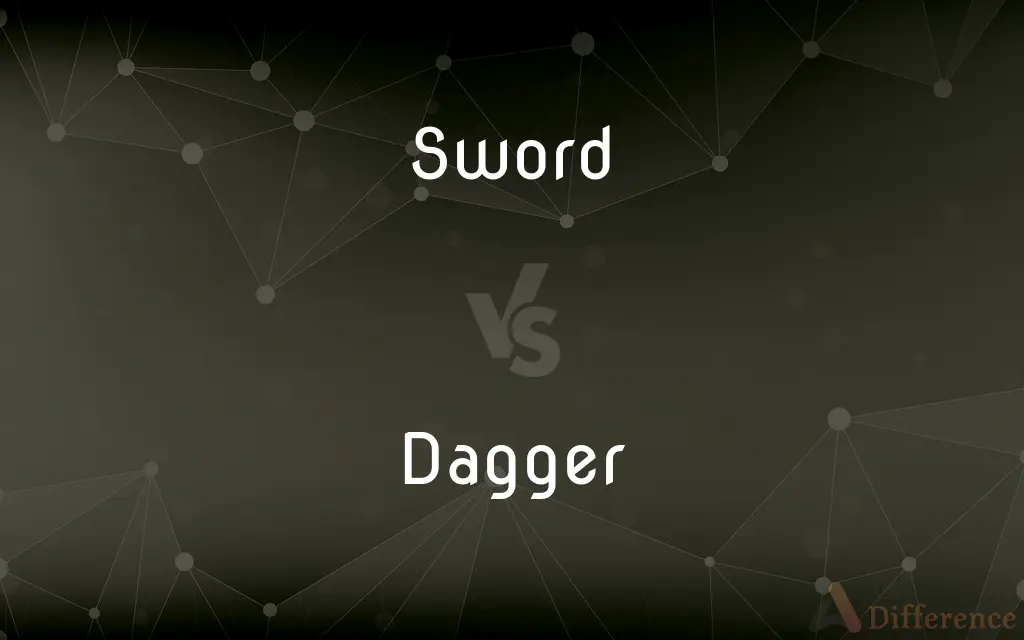Sword vs. Dagger — What's the Difference?
By Tayyaba Rehman & Maham Liaqat — Updated on April 18, 2024
Swords are long-bladed weapons designed for slashing and thrusting, while daggers are short stabbing weapons mainly for close combat.

Difference Between Sword and Dagger
Table of Contents
ADVERTISEMENT
Key Differences
Swords typically feature a long blade and are used in various martial traditions for slashing and thrusting movements. On the other hand, daggers have shorter blades, making them ideal for stealth and close-quarter combat, emphasizing stabbing more than slashing.
The design of a sword allows for greater reach and the ability to engage opponents from a distance, whereas daggers require the user to be much closer to the target, thus used effectively in surprise attacks or as a secondary weapon.
Swords often have a complex hilt that includes a guard, providing protection to the hand, while daggers usually have a simpler hilt that might include a small guard, but is primarily designed for a firm grip.
In historical and cultural contexts, swords are often symbols of power and dignity, seen in ceremonies and as part of military regalia. Conversely, daggers are typically viewed as tools of stealth and betrayal, often associated with covert operations or personal defense.
Swords require significant skill and training to wield effectively due to their size and weight. On the other hand, daggers are more accessible for untrained individuals due to their size and simplicity of use.
ADVERTISEMENT
Comparison Chart
Length
Usually over 60 cm
Typically under 30 cm
Usage
Slashing and thrusting
Primarily stabbing
Combat Range
Longer reach, suited for open combat
Close combat, stealth attacks
Symbolism
Honor, power, martial prowess
Stealth, betrayal, survival
Skill Required
High, requires training
Lower, easier to handle
Compare with Definitions
Sword
A tool in ceremonial contexts.
The officer carried a ceremonial sword during the parade.
Dagger
Used in idioms to express intensity or pain.
Her words were a dagger to his heart.
Sword
A symbol of authority and power.
The king's sword lay prominently displayed in the great hall.
Dagger
A component in certain ceremonies or rituals.
The dagger was used symbolically during the ritual.
Sword
Used in fencing to refer to a thin, pointed weapon.
They practiced with foils, a type of sword used in fencing.
Dagger
A symbol of betrayal or treachery.
The historical novel featured a dagger as a symbol of the betrayal among the royals.
Sword
A metaphor for warfare or battle.
He took up the sword against injustice.
Dagger
A short knife with a pointed and edged blade, used as a weapon.
The assassin concealed a dagger in his cloak.
Sword
A sword is an edged, bladed weapon intended for manual cutting or thrusting. Its blade, longer than a knife or dagger, is attached to a hilt and can be straight or curved.
Dagger
A dagger is a knife with a very sharp point and usually two sharp edges, typically designed or capable of being used as a thrusting or stabbing weapon. Daggers have been used throughout human history for close combat confrontations, and many cultures have used adorned daggers in ritual and ceremonial contexts.
Sword
A handheld weapon consisting typically of a long, straight or slightly curved, pointed blade having one or two cutting edges and set into a hilt.
Dagger
A short knife with a pointed and edged blade, used as a weapon
He drew his dagger and stabbed the leader
Sword
An instrument of death or destruction.
Dagger
A moth with a dark dagger-shaped marking on the forewing.
Sword
The use of force, as in war.
Dagger
A short pointed weapon with sharp edges.
Sword
Military power or jurisdiction.
Dagger
Something that agonizes, torments, or wounds.
Sword
(weaponry) A long-bladed weapon device with a grip- a hilt (a pommel and cross guard), which is designed to cut, stab, slash and/or hack.
Dagger
See obelisk.
Sword
(tarot) A suit in the minor arcana in tarot.
Dagger
A double dagger.
Sword
(tarot) A card of this suit.
Dagger
(weapons) A stabbing weapon, similar to a sword but with a short, double-edged blade.
Sword
(weaving) One of the end bars by which the lay of a hand loom is suspended.
Dagger
(typography) The text character †; the obelus.
Sword
(heraldry) The weapon, often used as a heraldic charge.
Dagger
A point scored near the end of the game (clutch time) to take or increase the scorer's team lead, so that they are likely to win.
Curry's last-minute 3-point dagger silenced the criticism for his so-called failure to come up big in big moments.
Sword
To stab or cut with a sword
Dagger
A timber placed diagonally in a ship's frame.
Sword
An offensive weapon, having a long and usually sharp-pointed blade with a cutting edge or edges. It is the general term, including the small sword, rapier, saber, scimiter, and many other varieties.
Dagger
To pierce with a dagger; to stab.
Sword
Hence, the emblem of judicial vengeance or punishment, or of authority and power.
He [the ruler] beareth not the sword in vain.
She quits the balance, and resigns the sword.
Dagger
A short weapon used for stabbing. This is the general term: cf. Poniard, Stiletto, Bowie knife, Dirk, Misericorde, Anlace.
Sword
Destruction by the sword, or in battle; war; dissension.
I came not to send peace, but a sword.
Dagger
A mark of reference in the form of a dagger [
Sword
The military power of a country.
He hath no more authority over the sword than over the law.
Dagger
A timber placed diagonally in a ship's frame.
Sword
One of the end bars by which the lay of a hand loom is suspended.
Dagger
To pierce with a dagger; to stab.
Sword
A cutting or thrusting weapon with a long blade
Dagger
A short knife with a pointed blade used for piercing or stabbing
Sword
A weapon with a long metal blade and a hilt with a hand guard.
The knight unsheathed his sword, ready for battle.
Dagger
A character used in printing to indicate a cross reference or footnote
Dagger
A tool for precise cutting in various crafts.
The artist used a dagger to carve details into the wood.
Common Curiosities
How is a dagger typically used?
Daggers are mainly used for stabbing, often in close combat or as a concealed weapon.
What types of swords are there?
There are many types, including longswords, katanas, and rapiers.
What is the primary use of a sword?
Swords are primarily used for slashing and thrusting in combat.
Is a dagger effective for self-defense?
Yes, due to its size and ease of handling, a dagger can be very effective for self-defense.
What are the cultural significances of a sword?
Swords often symbolize honor, authority, and martial prowess.
What is the difference in length between a sword and a dagger?
Swords typically measure over 60 cm in length, while daggers are usually under 30 cm.
What is the combat range difference between a sword and a dagger?
Swords are used in longer-range combat, while daggers are for close-quarters.
Can a sword be used for defense?
Yes, swords can be used defensively, particularly using the guard to block attacks.
Why might someone choose a dagger over a sword?
For ease of concealment and maneuverability, especially in tight spaces.
What does a dagger symbolize in historical contexts?
Daggers often symbolize stealth, treachery, and survival.
How do the hilts of swords and daggers differ?
Sword hilts are more complex, often including a protective guard, while dagger hilts are simpler and designed for a firm grip.
Share Your Discovery

Previous Comparison
Oakum vs. Tar
Next Comparison
Ballista vs. CatapultAuthor Spotlight
Written by
Tayyaba RehmanTayyaba Rehman is a distinguished writer, currently serving as a primary contributor to askdifference.com. As a researcher in semantics and etymology, Tayyaba's passion for the complexity of languages and their distinctions has found a perfect home on the platform. Tayyaba delves into the intricacies of language, distinguishing between commonly confused words and phrases, thereby providing clarity for readers worldwide.
Co-written by
Maham Liaqat















































